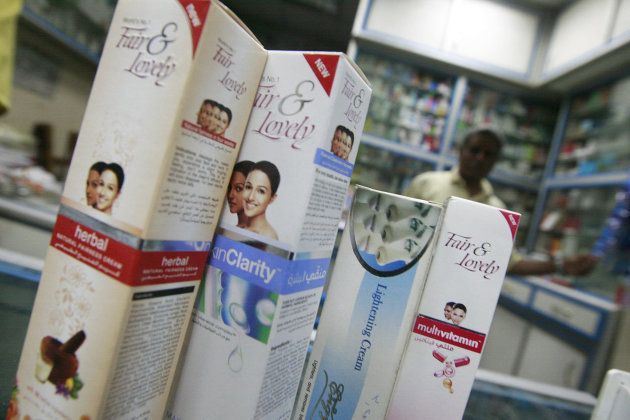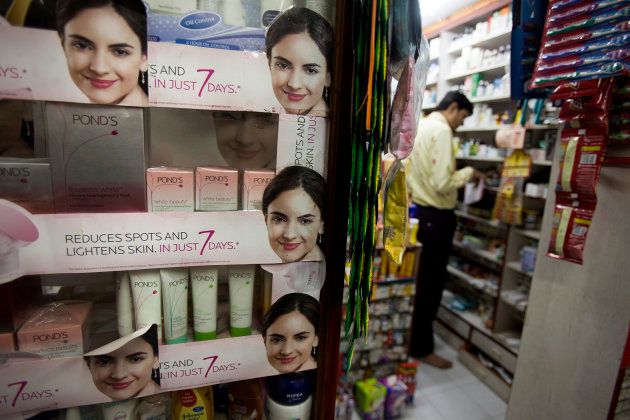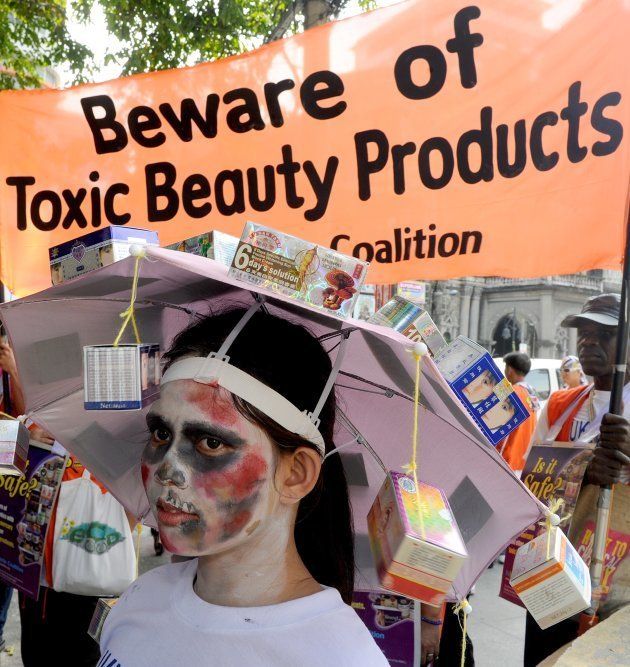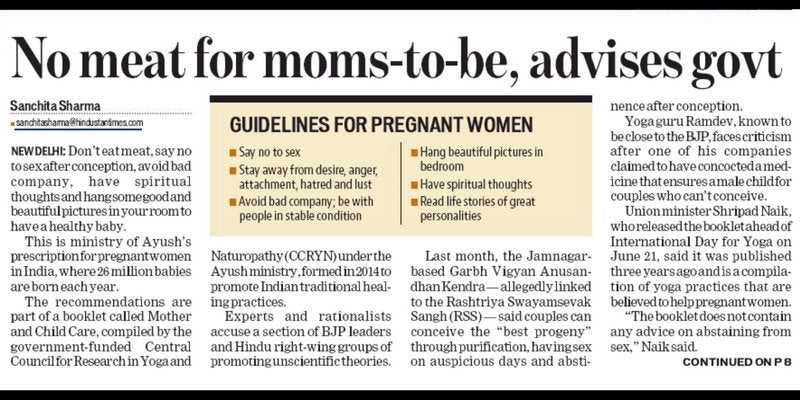
"Bhoot aaya, bhoot aaya, bhoot aaya." (The ghost is here, the ghost is here, the ghost is here.) Children scattered all over, shrieking and giggling, every time Sushmit Roychowdhury entered the playground in his school in Nagpur. Wiry and dark, he was an easy target of bullying in junior school.
By the time he was a teenager, Roychowdhury was applying Fair & Lovely on his face as a 'normal' chore — something as unquestionable as brushing his teeth.
It took him years, he says, to shrug off the conditioning that he must relentlessly try to lighten his skin, and, more importantly, to scorn suggestions of 'improving' his complexion, thrown at him by everyone — from salon professionals to acquaintances.
"In the kind of society we live in, these suggestions are supposed to be taken seriously, as the benevolence of a person who is genuinely concerned about your life," Roychowdhury, now 32, told HuffPost India. Every time he goes to a salon, anywhere in India, he is still asked to 'bleach' his face. "Gora dikhoge (You will look fair)" is like a rite of passage that must be completed with every single visit.
It's not easy to reclaim one's life from such constant badgering, especially when one is made to see it is as necessary life advice. Take the case of Rashmi*. Two years ago, she was bundled into a dermatologist's chamber at a leading hospital in south Delhi. Her face had developed blackish patches — like ink blotted on paper — all over. Horrified, the twenty-something's parents packed their bags and landed in Delhi from Patna. By that time, her skin had become unbearably irritable and reddened in parts.

When the doctor concluded it would be months before Rashmi's face went back to looking the way it was, she broke down in the chamber.
Roughly three months before this diagnosis, she had eagerly bought a cream the local chemist said would make her 'gori'. Soon to be married, Rashmi had always been told her dark skin would be a stumbling block. So when the chemist handed her a tube of cream, saying it wasn't like the usual fairness stuff, Rashmi was thrilled. He wasn't wrong either.
Within days, her face looked a shade lighter. Everyone noticed. Congratulations started doing the rounds. She went on using the cream, unfailingly, for months. Since she had not consulted a doctor, she stopped using it for a brief while, on a whim. That's when the trouble began, then quickly escalated, forcing her to scurry back to Delhi with her parents. By this time, her wedding was only two weeks away.
CREAMS THAT TAKE NO PRISONERS
Dr Rohit Batra, the man who knew what had happened to Rashmi the moment she walked into his chamber, wasn't the least bit surprised.
"She'd been using a cream with high dosage of steroids in it. What she thought was fairness was actually her skin corroding and becoming thinner. Then the side effects started surfacing," he told HuffPost India.
After the initial spasm of shock, Rashmi recovered. The treatment to wean her skin off these corrosive steroids began, but it would be weeks before the pigmentation would disappear and the skin grow back to its normal thickness.
"They decided to cover the pigments up with make-up for the wedding," Batra said. It took Rashmi six more months to regain her original skin. She was married by then.
Yet, within days of Batra confirming that her skin was back to normal, she requested a 'fairness' treatment, this time a less 'dangerous' one. Batra tried explaining that toying with one's natural complexion is a futile and dangerous exercise, but Rashmi, who had suffered the consequences, couldn't be persuaded to give up her quest for a 'cure'. Batra said he could not make her 'white' but could suggest skin-care routines to keep her skin healthy, glowing and to prevent it from tanning.
Batra tried explaining that toying with one's natural complexion is a futile and dangerous exercise that Rashmi had seen herself, but she couldn't be persuaded to give up her efforts to 'cure' her dark skin.
Cases like Rashmi's is now frighteningly familiar to Batra. "I get at least one, if not more patients, with exactly similar complications every day," he said. While he does get a number of men, the majority of cases he has to deal with involve women.
"By women I mean girls as young as 15 to women above 55 years of age, who all come with the same complaints," he says.
So what are these creams that are literally peeling the skin off people's faces? Mostly medication meant for another use.
Dr Koushik Lahiri, vice-president of the International Society of Dermatology, had to deal with hundreds of patients suffering from conditions like Rashmi's through his decades-long career.
"The creams they use are usually steroidal, often prescribed by dermatologists for cases of unnatural pigmentation. Suppose, you suddenly develop a dark patch on your face. If a skin specialist finds it to be a case of unnatural pigmentation, he/she may prescribe an ointment to be used just on that part of your face. Over days, the patch lightens and your skin goes back to looking normal," Lahiri told HuffPost India, from Kolkata.
What if one used these same creams on skin that's not diseased? It will have the same effect, lighten the pigmentation only, this time, it will affect the natural pigmentation, corroding perfectly healthy layers of skin.
It will have the same effect, lighten the pigmentation -- only, this time, it will affect the natural pigmentation, corroding perfectly healthy layers of skin.
Unfortunately, in India, there are chemists by the hundreds who don't know about this effect and/or won't tell you. Instead, they are likely to say that creams such as Betnovate are the hardcore fairness stuff: with guaranteed results.
Betnovate is prescribed medicine for hyper-pigmentation and must not be used daily. But try explaining this to someone made to feel miserable about their appearance all their lives? Certainly not chemists who readily hand over such creams to people who would go any length to make themselves 'fair'.
Perhaps such misuse of medical ointment wouldn't be this big a challenge in India were it not common to walk into a chemist's, name an ailment, and ask for a remedy at the counter. We do it for stomach bugs, for headaches, for fevers, itches, reddening eyes, sore throats and pretty much everything. It's the same with skin-lightening treatments.
THE VICIOUS CYCLE
Following years of suffering from Topical Steroid Addiction (TSA) — the condition most people using steroidal creams for fairness have — Soumita Guha has found a perfect analogy for it.
"I often think it is a bit like alcoholism. Only, here your skin is the alcoholic. Like alcoholics feel wretched withdrawal symptoms when they stop drinking, your skin too goes mad when you stop feeding it these steroids. And as in alcoholism, the way back is painful and tedious," Guha, in her late 20s, and employed with an MNC, told me on the phone from Kolkata.
Guha, however, didn't fall into the TSA cycle to lighten her skin. She suffered from a skin condition which caused her to develop rashes on her face frequently. So she was prescribed a cream with strong steroids by a doctor. When the rashes seemed to be diminishing, Guha stopped using the cream. Within days, the rashes were back — giant red welts all over her face, stubborn to any natural soothing agent, itchy and occasionally oozing puss.

"I was horrified. That cream was supposed to have cured me! So I went to another doctor," she said. The second doctor prescribed her another cream, one which had nearly twice as much steroids. Thus the cycle to suppress the effect of one steroid with a stronger one started and Guha's skin barely put up with the ravage. It is then that she found Dr Lahiri, who diagnosed her disease for what it was: TSA.
Guha's case was simply unfortunate, she needed a cure for her rashes and it led to more complications as is the nature of TSA.
Now, imagine going through the same process with perfectly healthy skin?
That's what Jitesh* from Surat did. Only, he didn't go seeking a cream to improve his complexion at the chemist's in the Mumbai suburb he lived.
Jitesh had stopped by at the chemist's to check if they had anything for a stubborn inflammation which surfaced on his face and didn't dry up. He was given a tube of Mometasone. He started applying it on the sore spot and soon the inflammation reduced and disappeared. However, Jitesh noticed that the half-inch stretch on his cheek was at least a shade lighter than his natural skin colour.
"What if I use it all over my face?" he thought. Bingo, his little experiment was yielding results! His skin was lighter after regular use for a few weeks, so he stopped. But, like Rashmi, all hell broke loose. Jitesh could barely spend a minute without wanting to itch his face. His skin turned the colour of carrot and the moment he stepped out in the sun, his face felt like it was on fire.
Jitesh could hardly spend a minute without wanting to itch his face, his skin turned the colour of carrot and the moment he stepped out in the sun, his face felt like it was on fire.
He landed at the Mumbai chamber of Dr Uday Khopkar, who, like Dr Batra and Dr Lahiri, wasn't surprised. "I get at least 2-3 such patients every day. Initially, a majority of them used to be women, now the number of male patients is fast catching up," Khopkar told HuffPost India.
WOULD A MANDATORY PRESCRIPTION FOR SALE STOP IT?
The answer to the question above is: not entirely, but it would be of immense help, Dr Lahiri said.
"These creams are cheap, between ₹20-100 for a tube. So it is doubly easier for chemists to sell them and for people to buy, without considering what they are getting into. They are also necessary for certain skin ailments, so we need them. Hence, the demand for prescriptions," he explained.
Last year, he started a petition demanding that prescriptions be made mandatory for the sale of steroidal creams on change.org.
Lahiri also has a great perfect analogy for such disasters. "Nuclear energy is essentially not bad, right? It's fine if you're using it to light people's homes, but absolutely unforgivable and dangerous if you use it to bomb homes. Unfortunately, you can do both. So you have to put regulations in place to prevent abuse. The place of steroids in medicine is a bit like that," he says.
In comparison, widely advertised creams like Fair & Lovely are not actually dangerous, though they are completely ineffectual in lightening skin tones, most doctors feel. "At the most, they can remove a little bit of tan but that, too, nothing visible," said Dr Lahiri.
IS THE ANGER AT SUCH POPULAR CREAMS MISDIRECTED?
Not at all, most doctors said. They may not be harming your skin, but the havoc they wreak is more than skin-deep. It's psychological. And it has a lot to do with how these creams are advertised and marketed.
For years, marketeers and advertisers have tried to peddle skin-lightening products by suggesting that 'fair' skin is the ticket to love, success and acceptance. It won't be entirely wrong to say that these creams and their big-budget marketing blitzkrieg lead thousands of Indians into the steroid trap.
"Fair and lovely will neither make your fair nor lovely. However, suppose a vulnerable person sees no result following years of use, he or she will seek something better. Only, the alternative will hardly any better," Dr Lahiri pointed out.
A government regulation forbids companies to package any cream saying its purpose is to enhance skin fairness. But the restriction applies only to printing such a message on the pack, not to advertising them.
"Often they use garbed words like glowing, bright, gleaming skin. But the message is conveyed anyway," Lahiri added.
In 2014, the Advertising Standard Council of India (ASCI) made an effort, within its powers, to rein in this scourge. Since they are no authority to regulate the sale of the creams, they tried to intervene and fix the portrayal of dark skin in advertisements. They issued clear guidelines stating no commercial produced in India can associate failure, depression, negativity with dark skin. Models acting in such productions must not be made to look unhappy about having dark skin — a popular trope in the earlier ads. Also, dark skin couldn't be associated in a demeaning way with class, caste, religion and so on.
Since they are no authority to regulate the sale of these creams, they tried to intervene and fix the portrayal of dark skin in advertisements.
Have you wondered why the new crop of ads have women complaining about chipchipi (sticky) skin? Or of dryness and not dark skin? Now you know.
The Indian Association of Dermatologists, Venereologists and Leprologists, of which Dr Batra is a part, is also stepping up efforts to raise awareness about the abuse of steroidal creams. "It's unimaginable, this scourge. The sad part is when patients keep pestering, often dermatologists given them these creams so that they keep coming back to them and business is booming," he said.
Steroid abuse for fairness is an epidemic in India and hardly anyone is talking about it. If it goes undetected and untreated, it could lead to death.
Deepashree Daulatabad, a dermatologist with Delhi's Maulana Azad Medical College, confirms that the problem cuts across class, caste and region. As a doctor at a government hospital, mostly frequented by people with low income, Daulatabad deals with 4-5 cases of steroid abuse for 'white' skin every day.
Such sales without prescriptions have landed even infants on her doorstep. "Say, they went to a chemist first to treat a boil on a baby's face and the person ended up giving a high dose steroid used on adults. The infant was brought in with a bloated face and skin peeling off," she said.
Lahiri pointed out often mothers use creams prescribed to children for rashes on their own faces after realising that a patch on the child's face has become lighter.
Do parents use creams meant for them on children too? "You take a guess," Lahiri said.
INJECTIONS FOR SKIN WHITENING
Ask the Internet for a sure-fire way to get lighter skin, actually, completely fair skin from completely dark skin and a Google search and one phone call later, you will learn the answer: only 25-26 injections.
These 'magic' injections, offered by a host of 'fairness' clinics, comprise a compound called glutathione. Glutathione exists in edible varieties as well as tablets sold as 'dietary supplements'.
"These are off-label drugs," Daulatabad, who co-authored an academic article on the use and abuse of glutathione with Dr Siddharth Sonthalia and Dr Reshmi Sarkar, told HuffPost India. And were not meant for skin-whitening.
If you search the drug in the Central Drugs Control Organisation's website, you'll find that the regulatory body had approved the manufacture of injectable glutathione only for the following purposes in India: "treatment of alcoholic liver diseases like alcoholic fatty liver, alcoholic liver fibrosis, alcoholic liver cirrhosis, and hepatitis".
These 'magic' injections, offered by a host of 'fairness' clinics, comprise a compound called glutathione.
"On the box they say the injections are for alcoholic liver, but chemists are directed by manufacturers to push sales for the purpose of skin whitening, since that is a more profitable market than its actual use," said Sonthalia, who has done extensive research into the use of glutathione. However, he added, like other medicines prescribed for uses apart from the one it was initially intended for, it is perhaps not 'unlawful' to administer glutathione for skin-lightening.

"I consulted 7 companies (dermatology) who are currently providing IV GSH to dermats for skin lightening purposes. Although the printed approved indication on all the package inserts say that IV GSH is approved only for liver disorders in India," Sonthalia said.
Injectable glutathione is not always purchased directly from the manufacturers by the retailers. Sonthalia found that most of the glutathione for skin lightening is sourced by tertiary companies from approved manufacturers like Lyka Labs and INTAS Pharma and then sold to dermatologists or cosmetic clinics.
The drug comprises strong anti-oxidants that can fight corrosive effects of UV radiation — the reason why they are occasionally prescribed to people undergoing chemotherapy.
"Apart from this so-called 'proper channel' use of IV gluta for skin lightening, a huge proportion of patients as well as doctors get IV gluta imported online — primarily owing to lower costs. There is currently no way of estimating this amount," Sonthalia added.
When we called Lyka Labs, one of the first laboratories to be given permission by the DCGI to manufacture injectable glutathione, it confirmed that not only does one have to show a prescription for its purchase but it is also manufactured by them only to treat liver diseases.
The drug comprises strong anti-oxidants that can fight corrosive effects of UV radiation — the reason why it is occasionally prescribed to people undergoing chemotherapy.
By that logic, Daulatabad and Sonthalia's article pointed out, it should be able to battle effects of sunlight on human skin. But here's the catch: since the drug was never meant for such use, there is no empirical evidence to suggest that it has no side-effect when employed as a skin-whitening agent. Using it for this purpose is like shooting in the dark.
The same article points out that glutathione's skin-whitening side-effects were discovered by chance — when someone was administered with a high dose of the drug by mistake. Since then, black marketeers abroad turned it into a bustling, skin-whitening business, forcing the Food and Drugs Administration (FDA) of US to ban its use as a skin-whitening agent. In the Philippines, the country's FDA have issued several bans on several forms of glutathione for the same rampant, unapproved use, including of glutathione tablets and injections, as the abuse was getting out of control.
The reason there's little pushback against the abuse of glutathione injections in India is because they make for great business.
The reason there's little pushback against the abuse of glutathione injections in India is because they make for great business. "It actually quite shameful, but I know clinics which charge more than ₹30,000 for one session of glutathione IV drip," Sonthalia said.
No wonder the person at a Delhi Clinic with a Kafkaesque name which we called told us it is possible to be completely 'whitened'. Each session would cost ₹6,000-8,000, but discounts may apply.
A vial of glutathione, sold by Lyka, costs ₹1,299. Either these injections are of thrice the dosage amount of 600 gms per vial or easy profit-making mascots for such clinics. These are also available in packs that cost between ₹4,000-24,000 on popular online retailing sites.
Though there has been no formal study, one distributor told Sonthalia that the business of selling injectable glutathione for skin whitening could be worth anywhere between ₹20-30 crore in India, leaving aside the online purchases which form a bulk of it.

As Daulatabad's article points out, in India, several 'clinics' offer IV drips comprising glutathione for skin whitening. "Manufacturers of intravenous glutathione injections recommend a dose of 600–1200 mg for skin lightening, to be injected once to twice weekly. The duration for which they should be continued is not specified," the article says.
"Manufacturers of intravenous glutathione injections recommend a dose of 600–1200 mg for skin lightening, to be injected once to twice weekly. The duration for which they should be continued is not specified.
Sonthalia recently found that the only clinical trial conducted to check the effect of injectable glutathione on complexion took place in Pakistan, not long back.
The study, published in a dermatologists' journal, said doctors found no visible difference in skin tones of the subjects after administering injectable glutathione. But some of those who had signed up for trials hastily dropped off after a few complained they had to be treated for liver-related ailments following the trials.
"Imagine this: a drug meant as a cure for liver disease could actually be causing healthy livers to malfunction," Sonthalia said. He also mentioned that since the magazine which published this study is not affiliated to the most trusted medical journal vetting authority in the world, its results should be taken with a pinch of salt.
Imagine this: a drug which is meant as a cure for liver disease could actually be causing healthy livers to malfunction.
The Philippines government, alarmed at the rampant use of injectable glutathione, issued a public warning, saying that customers run the risk of contracting rashes and suffering from fatal conditions like Steven Jonson's Syndrome. Additionally, it cautioned people against renal failure and lethal infections contracted from unhygienic administering of the injection by untrained staff.
I searched all available resources to find if Indian authorities also issued similar warnings, but none seem to exist. It's hard to estimate the worth of this black market in India, but with no regulation or crackdown in sight, it seems destined to grow.
Also on HuffPost
